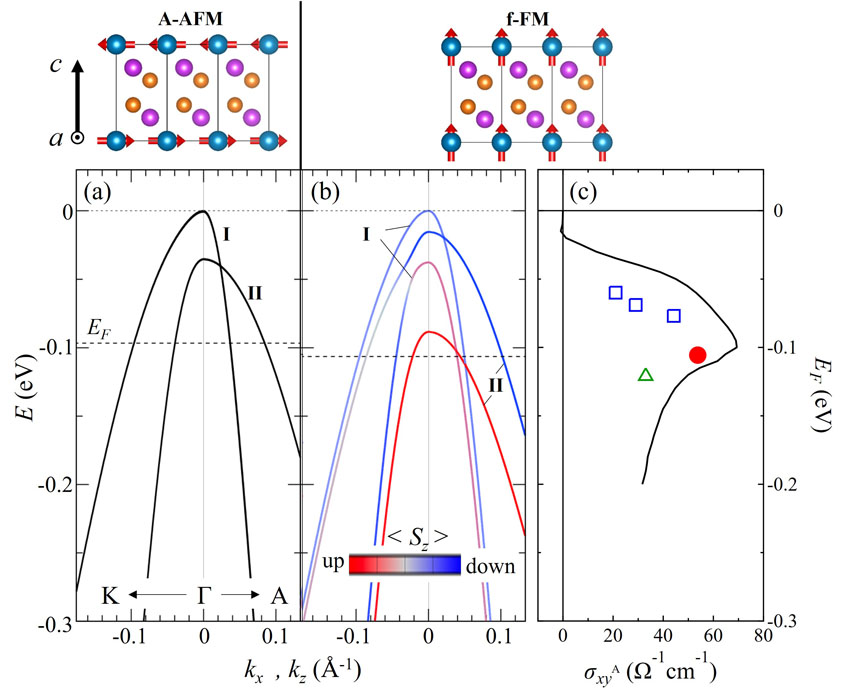Large Anomalous Hall Effect Induced by Field-Tunable Weyl Points in Antiferromagnetic Degenerate Semiconductor EuMg2Bi2
PI of Joint-use project: H. Sakai
Host lab: Tokunaga Group
Host lab: Tokunaga Group
Weyl magnets, which have the topologically nontrivial band crossing points, have recently attracted significant attention because of the unconventional physical properties, such as large anomalous Hall effects (AHE). The typical materials have a semimetallic band structure where many bands cross the Fermi energy (EF), resulting in complicated band structures and Fermi surfaces that hinder a simple understanding of their Weyl physics. In this study, we report on the field-tunable Weyl points in the degenerate antiferromagnetic semiconductor EuMg2Bi2, which has a simple and small Fermi surface. EuMg2Bi2 has a CaAl2Si2-type structure, which consists of the alternative stacking of the Eu magnetic layer and the Mg2Bi2 buckled-honeycomb layer (Fig. 1(a)). The former layer exhibits the A-type antiferromagnetic (A-AFM) order below TN ~ 6.7 K at zero field. When the field is applied along the c -axis, Eu spins start canting toward the c-axis and are fully polarized above Bc ~ 4 T at 2 K. The latter layer forms the semiconducting band with the direct band gap at the Γ point, resulting in the simple Fermi surface. Therefore, it is expected that, in the magnetic field, the spin-polarized band crossing points (Weyl points) are formed while maintaining a simple band structure due to the spin splitting caused by the exchange interaction with local Eu spins. To reveal the impacts of the Eu magnetism on the band structure of EuMg2Bi2, we synthesized the large single crystal (Fig. 1(b)) and performed the various measurements and the first-principles calculations.

Fig. 1. (a) The crystal structure of EuMg2Bi2. (b) The photograph of the single crystal of EuMg2Bi2. (c) The field dependence of ρyx and its anomalous part ρAyx at 2 K. The black dotted line corresponds to the ordinary part ρNyx obtained from the liner fit to the experimental data above Bc. Note here that the ρNyx is vertically shifted to demonstrate the fitted result at the high-field region. The red curve represents the field dependence of the magnetization M at 2 K. Insets show the magnetic structure of Eu spins at canted-antiferromagnetic (AFM) and forced-ferromagnetic (f-FM) phases. (d) Field dependence of ρxx at T = 1.4 K up to B ~ 50 T. Triangles denote the oscillatory component. The inset shows the oscillatory component Δρxx.
Figure 1(c) shows the field dependence of the Hall resistivity ρyx at 2 K for the field along the c-axis. Although, ρyx is almost linear with respect to field above Bc, it deviates from the straight line below Bc and shows a hump structure at approximately 2.5 T. This signals the AHE coupled with Eu magnetic order. To extract the anomalous component ρ
To obtain the detailed information of the Fermi surface, we measured the several physical properties up to ~ 55 T using the nondestructive mid-pulse magnet. Figure 1(d) shows the field dependence of the resistivity ρxx. As denoted by black triangles, we observed clear oscillatory structure. These oscillations are periodic with respect to 1/B [see inset of Fig. 1(d)], which indicates the quantum oscillation arising from the Landau quantization. By Onsager’s theorem, we can estimate the cross-section SF (~ 0.352 nm-2) of the Fermi surface from the oscillation frequency BF (~ 36 T), which allows us to determine the position of EF in combination with the first-principles calculation shown below.
Figure 2(a) shows the calculated band structure around the Γ point for A-AFM phase. The two valence bands I and II cross each other on the Γ−A line, leading to a Dirac-like point located far from the EF. When the field is applied along the c-axis, both bands exhibit a spin splitting because of the exchange interaction with the local Eu spins to form the multiple Weyl points. The position of the Weyl points shifts with increasing the magnitude of the spin splitting. Intriguingly, in the f-FM phase, one of the Weyl points are formed in the vicinity of EF (Fig. 2(b)), which is determined to be ~ 110 meV from the comparison between the experimental and theoretical values of SF and carrier density obtained from the Hall coefficient [1]. To clarify the intrinsic AHE due to the Berry curvature of the Weyl point, we calculated the EF dependence of the anomalous Hall conductivity σ

Fig. 2. (a, b) Valence band structures around the Γ point near EF (lower panels) for various magnetic states (upper panels). Red and blue colors of band dispersions represent spin up and spin down, respectively. The dotted lines denote the Fermi energy EF determined from the quantum oscillation frequency BF at T = 1.4 K. (c) Anomalous Hall conductivity σAxy as a function of EF. The solid black curve represents the calculated result for the f-FM phase. The solid red circle denotes the experimental data (2 K, 9 T) for pristine EuMg2Bi2, while the open blue squares and open green triangle denote those for the annealed crystals and In-doped crystal, respectively.
References
- [1] M. Kondo et al., Physical Review B 107, L121112 (2023).
- [2] E. Liu et al., Nat. Phys. 14, 1125 (2018).
- [3] K. Kim et al., Nat. Mater. 17, 794 (2018).
- [4] T. Suzuki et al., Nat. Phys. 12, 1119 (2016).
